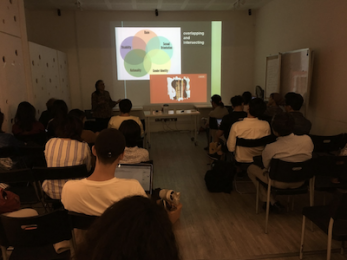-
Advocacy Theme
-
Tags
- Abortion
- Adoption
- Caregiving
- CEDAW
- Disability
- Domestic Violence
- Domestic Workers
- Harassment
- Healthcare
- Housing
- International/Regional Work
- Maintenance
- Media
- Migrant Spouses
- Migrant Workers
- Muslim Law
- National budget
- Parental Leave
- Parenthood
- Polygamy
- Population
- Race and religion
- Sexual Violence
- Sexuality Education
- Single Parents
- Social Support
- Sterilisation
- Women's Charter
A recap: Intersectionality in Malaya’s feminist movements
October 4th, 2018 | AGM and AWARE Updates, Events, Gender-based Violence, Muslim Women's Rights, News
By Firqin Sumartono, AWARE volunteer
 On 25 September, Associate Professor Maznah Mohamad held a talk at AWARE on intersectionality of the women’s movement in Malaya. The term ‘intersectional’ was coined by Kimberlé Crenshaw (1989) which views that “cultural patterns of oppression are not only interrelated, but are bound together and influenced by the intersectional systems of society. Examples of this include race, gender, class, ability, and ethnicity.”
On 25 September, Associate Professor Maznah Mohamad held a talk at AWARE on intersectionality of the women’s movement in Malaya. The term ‘intersectional’ was coined by Kimberlé Crenshaw (1989) which views that “cultural patterns of oppression are not only interrelated, but are bound together and influenced by the intersectional systems of society. Examples of this include race, gender, class, ability, and ethnicity.”
The term ‘intersectional feminism’ has been gaining momentum and visibility recently. However, the idea of intersectionality in social justice and in women’s rights in the local and regional context may still be in its early stages. This lecture highlighted how movements in the past may be intersectional in nature.
According to Maznah, women in the colonial era played a major role in determining regional politics and power. But recorded history mostly focused on those from the elite class – the efforts made by the working class in Malaya during that time were largely forgotten. The erasure of women’s roles in historical events has led to the assumption that women did not play a part in the region’s nation-building movements.
Maznah noted the anti-colonial movement led to other movements that transcended class. The need for liberation from colonisers required a coordinated effort from everyone in the region, regardless of gender, or class. Anti-colonial movements and groups fighting for national liberation were set up. However, these efforts were still divided by race. Women like Rasammah Bhupalan, Shamsiah Fakeh, Devaki Jayar and Lim Min, fought for the same cause, but their organisations were based on their ethnic background. Racial categorisation – a legacy of colonial practices – divided these women within the stipulated racial silos of Malaya.
The postcolonial world brought about the beginnings of a women’s movement created by women for women; where the fight for rights and equal access to education and work became more united and was not restricted to the categorisation of ethnicity. Maznah pointed to the formation of Singapore Council of Women (SCW) in 1952 where the founder, Shirin Fozdar, played a key role in mobilising women politically. The multiracial committee of SCW was significant in presenting women’s issues on a national stage and lobbied for the billing of women’s rights in marriage, which resulted in the Women’s Charter Bill being passed in 1961.
During the Q&A session, there were questions on how to be more intersectional in practice and not just in theory. Maznah emphasised that intersectionality does not live in a vacuum. It requires a deep understanding of the diverse lived experiences of women. It is important to understand that individuals do not exist within a constructed boundary, nor are our issues independent of each other. While intersectionality as a concept is gaining currency and interest, it should also be reflected in our actions too; where we hold spaces for marginalised groups and include these narratives in discourses and perspectives.



